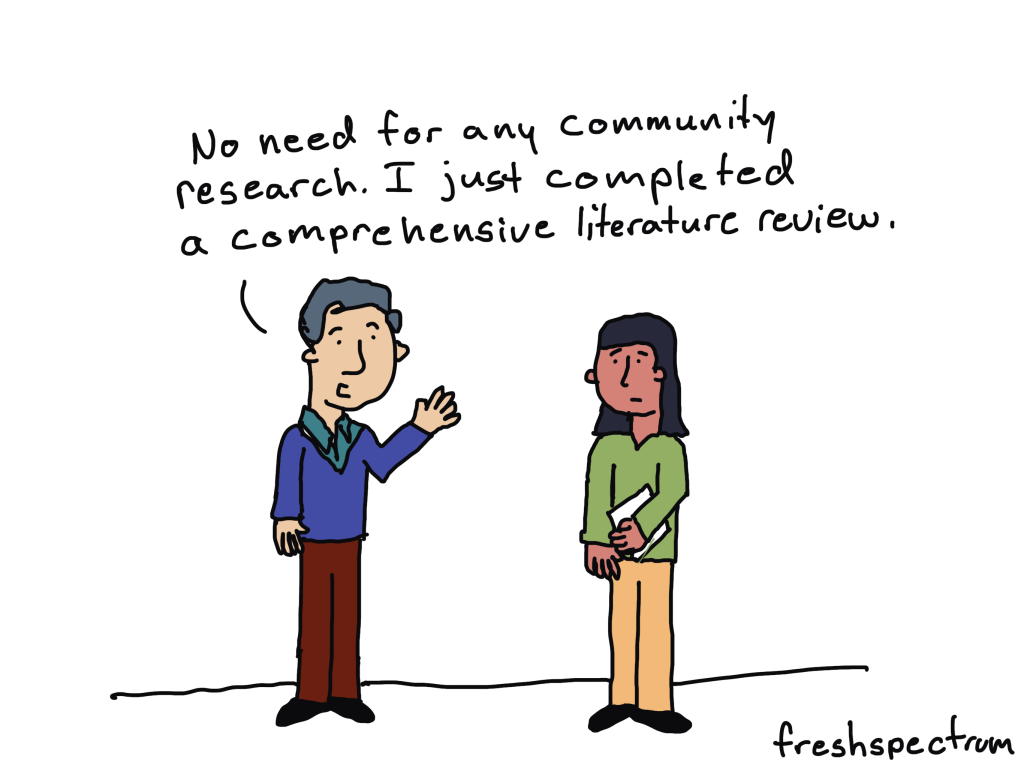This is an Eval Central archive copy, find the original at freshspectrum.com.
Over the coming year I hope to spend a little time on this blog showcasing some of the members of my Information Design Academy.
In today’s post we’ll hear from Joanna Prout. Joanna is currently exploring a career transition from research and evaluation into the field of user experience research. I asked her to share some of the lessons she has learned through her exploration.
Who is Joanna Prout?
Joanna is a researcher, evaluator, and PhD Psychologist currently working as a leader researcher for the University of Maryland School of Medicine. You can learn more about Joanna, and follow her work, by visiting her LinkedIn profile.
What is User Experience Research?
Before we get to Joanna’s lessons, let me give you a couple of resources that will provide you with a basic intro to UX research.
UX (user experience) research is the systematic study of target users and their requirements, to add realistic contexts and insights to design processes. UX researchers adopt various methods to uncover problems and design opportunities. Doing so, they reveal valuable information which can be fed into the design process.
UX Research – Interaction Design Foundation
User-experience research methods are great at producing data and insights, while ongoing activities help get the right things done.
UX Research Cheat Sheet – Nielsen Norman Group

Now let’s get into the 4 lessons Joanna shared with me over email (in her own words).
1. Think about what the product is.
A big shift in learning about UXR was thinking about anything that I was doing research about as a “product.” Once I understood that anything can be a product, it didn’t have to be like a blender that could sit on a shelf at a store, the transition became easier because I realized that I already had done research about products like trainings, online resource centers, data dashboards, etc.
This shift in thinking helped me realize that all the research I did should be aimed at improving the product we were creating. Digging into data just because it is “interesting” can be fun but it is less likely that this work will be used because there aren’t clear connections to action steps.
2. Generative Research is key.
Another thing I learned about was generative research – this isn’t really done at my university position because we assume we know what is best for people or what people need based on science. However, the guidelines provided by science are typically very broad and the product will need to be tailored to the specific users. Actually talking to the people you hope will use your product can make it work a lot better!
3. Research as a tool to build community and get buy-in.
Academic research for me was pretty removed from the world and the people it was about or for. With generative research and iteration, it is easier to get buy-in because all the stakeholders can be involved in creating and refining the product. Doing 1:1 interviews with people at the start of our Data 2 Action toolkit helped me build relationships with key people because I got an hour just to get to know them.
Summative and evaluative work is similar– if you work closely with the people who will use it then you are more likely to get reports that they will be excited to use. The limitation here is that there has to be flexibility– this kind of research isn’t going to be the same as very controlled studies where the goal is to determine if the null hypothesis is true. So, there is a lot of ambiguity that you just have to be comfortable with.
4. UX Research has a Great Community.
Those are some thoughts! The other great thing about UXR is the community. In academia people will purposefully not help you because they don’t want you to scoop their findings and take their grant money. There may be some of that in industry but in general people have been really open to volunteering their time & resources just to help me.
Have you done your own research into the fields of UX Research or UX Design? What have you learned?
This is Chris again.
For myself, I have incorporated a number of UX Design methods into my overall information design practice. I find the set of methods really useful for my work.
I know there are other evaluators and researchers who have jumped into jobs in tech as UX Researchers and UX Designers. Are you one of them? Have you explored these areas? Let us know in the comments what you have learned.
Oh, and if you want to be cool like Joanna, consider joining us and becoming a member > Information Design Academy.